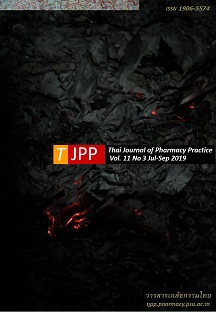ประสิทธิภาพของแบบจำลองเภสัชจลนศาสตร์ประชากรของยาลิเทียมในผู้ป่วยชาวไทย
Main Article Content
บทคัดย่อ
วัตถุประสงค์: เพื่อประเมินประสิทธิภาพของแบบจำลองเภสัชจลนศาสตร์ประชากรของ Yukawa และคณะในการทำนายระดับยาลิเทียมที่สภาวะคงที่ในกลุ่มผู้ป่วยโรคอารมณ์สองขั้วชาวไทยโดยเปรียบเทียบกับวิธีดั้งเดิม วิธีการ: การศึกษานี้เก็บข้อมูลในผู้ป่วย 140 รายแบบย้อนหลัง ตัวอย่างเป็นเพศหญิง 85 ราย มีอายุและน้ำหนักเฉลี่ย 36.3 ปี และ 63.7 กิโลกรัม ตามลำดับ ประสิทธิภาพในการทำนายระดับยาลิเทียมที่สภาวะคงที่ของแบบจำลองของ Yukawa และคณะและวิธีดั้งเดิมถูกประเมินโดยร้อยละของความคลาดเคลื่อนสัมบูรณ์ในการทำนาย ค่าเฉลี่ยร้อยละของความคลาดเคลื่อนสัมบูรณ์ในการทำนาย และ ค่ารากที่สองของความคลาดเคลื่อนเฉลี่ยกำลังสอง ผลการวิจัย: ระดับยาลิเทียมที่สภาวะคงที่ที่ทำนายได้จากแบบจำลองของ Yukawa และคณะ มีอคติต่ำกว่าวิธีดั้งเดิมอย่างมีนัยสำคัญทางสถิติ ค่าเฉลี่ยร้อยละของความคลาดเคลื่อนสัมบูรณ์ในการทำนายที่ได้จากแบบจำลองของ Yukawa และคณะ และวิธีดั้งเดิมเท่ากับ 16.65 และ 24.01 ตามลำดับ (P < 0.001) แบบจำลองของ Yukawa และคณะ มีค่าความแม่นยำสูงกว่าวิธีดั้งเดิม ค่ารากที่สองของความคลาดเคลื่อนเฉลี่ยกำลังสองที่ได้จากแบบจำลองของ Yukawa และคณะ และวิธีดั้งเดิมเท่ากับ 19.37 และ 30.84 ตามลำดับ (P < 0.001). สรุป: แบบจำลองเภสัชจลนศาสตร์ประชากรของยาลิเทียมที่พัฒนาโดย Yukawa และคณะมีประสิทธิภาพในการทำนายระดับยาลิเทียมที่สภาวะคงที่สูงกว่าวิธีดั้งเดิม จึงสามารถพิจารณาเลือกใช้แบบจำลองนี้ในการประมาณค่าอัตราการกำจัดยาลิเทียมนอกเหนือจากการใช้วิธีดั้งเดิม ในการกำหนดขนาดยาลิเทียมที่เหมาะสมให้แก่ผู้ป่วย
Article Details
ผลการวิจัยและความคิดเห็นที่ปรากฏในบทความถือเป็นความคิดเห็นและอยู่ในความรับผิดชอบของผู้นิพนธ์ มิใช่ความเห็นหรือความรับผิดชอบของกองบรรณาธิการ หรือคณะเภสัชศาสตร์ มหาวิทยาลัยสงขลานครินทร์ ทั้งนี้ไม่รวมความผิดพลาดอันเกิดจากการพิมพ์ บทความที่ได้รับการเผยแพร่โดยวารสารเภสัชกรรมไทยถือเป็นสิทธิ์ของวารสารฯ
เอกสารอ้างอิง
2. Merikangas KR, Jin R, He J-P, Kessler RC, Lee S, Sampson NA, et al. Prevalence and correlates of bipolar spectrum disorder in the world mental health survey initiative. Arch Gen Psychiat. 2011;68:241-51.
3. Sayers J. The world health report 2001-Mental health: new understanding, new hope. Bull World Health Organ 2001; 79: 1085.
4. Belmaker R. Bipolar disorder. N Engl J Med. 2004; 351: 476-86.
5. Price AL, Marzani-Nissen GR. Bipolar disorders: a review. Am Fam Physician. 2012;85:483-93.
6. Sproule B. Lithium in bipolar disorder. Clin Pharmaco kinet. 2002;41:639-60.
7. Bauer LA. Applied clinical pharmacokinetics. New York: McGraw-Hill; 2001.
8. Murphy JE. Clinical pharmacokinetics. 5th ed. Bethesda: American Society of Health-System Pharmacists; 2011.
9. Winter ME. Basic clinical pharmacokinetics. 4th ed. Philadelphia: Wolters Kluwer/Lippincott Williams & Wilkins Health; 2010.
10. Huang HC, Chang YL, Lan TH, Chiu HJ, Liu WM, Lee T. Prediction of optimal lithium doses for Taiwan ese psychiatric patients. J Clin Pharm Ther. 2008; 33: 115-21.
11. Yukawa E, Nomiyama N, Higuchi S, Aoyama T. Lithium population pharmacokinetics from routine clinical data: role of patient characteristics for estimating dosing regimens. Ther Drug Monit 1993; 15: 75-82.
12. ElDesoky ES, Kumar V, Alorainy MS, Hamdi MM, Derendorf H. Estimation of lithium clearance from routine clinical data in Egyptian bipolar patients. A population pharmacokinetic approach. Int J Clin Phar macol Ther 2008; 46: 617-26.
13. Findling RL, Landersdorfer CB, Kafantaris V, Pavu luri M, McNamara NK, McClellan J, et al. First-dose pharmacokinetics of lithium carbonate in children and adolescents. J Clin Psychopharmacol. 2010; 30: 404-10.
14. Jermain D, Crismon M, Martin ES 3rd. Population pharmacokinetics of lithium. Clin Pharm 1991;10: 376 -81.
15. Landersdorfer CB, Findling RL, Frazier JA, Kafan taris V, Kirkpatrick CM. Lithium in paediatric patients with bipolar disorder: implications for selection of dosage regimens via population pharmacokinetics/ pharmacodynamics. Clin Pharmacokinet. 2017; 56: 77-90.
16. Perez-Castello I, Mangas-Sanjuan V, Gonzalez-Garcia I, Gonzalez-Alvarez I, Bermejo M, Marco-Garbayo JL, et al. Population pharmacokinetic model of lithium and drug compliance assessment. Eur Neuropsychopharmacol. 2016;26:1868-76.
17. Yu W, Sun X, Li Y, Li M, Wang K, Li H. Population pharmacokinetics of lithium carbonate in young male healthy Chinese volunteers. Pharmacopsychiatry 2016; 49: 177-81.
18. Zetin M, Garber D, de Antonio M, Schlegel A, Feureisen S, Fieve R, et al. Prediction of lithium dose: a mathematical alternative to the test-dose method. J Clin Psychiatry. 1986; 47: 175-8.
19. Lobeck F, Nelson M, Evans R, Hornstra R. Evaluation of four methods for predicting lithium dosage. Clin Pharm 1987; 6:230-3.
20. Cooper TB, Bergner PE, Simpson GM. The 24-hour serum lithium level as a prognosticator of dosage requirements. Am J Psychiat. 1973;130:601-3.
21. US Food and Drug Administration. Guidance for industry: population pharmacokinetics [online]. 1999. [cited Jun 9, 2018]. Available from: www.fda.gov/ downloads/drugs/guidances/UCM072137.pdf.
22. Ette EI, Williams PJ. Population pharmacokinetics II: estimation methods. Ann Pharmacother 2004; 38 :1907-15.
23. Owen JS, Fiedler-Kelly J. Introduction to model evaluation. In: Owen JS, Fiedler-Kelly J, editors. Introduction to population pharmacokinetic/pharmaco dynamic analysis with nonlinear mixed effects models. New Jersey: Wiley; 2014. p. 212–31.
24. Sukon P. Assessing accuracy and precision of developed equations in prediction of blood lithium levels in psychiatric patients in Khon Kaen Rajanagarindra Psychiatric Hospital. Isan Journal of Pharmaceutical Sciences. 2013;9:82-93.
25. Suwan P. Prediction of steady state serum lithium concentrations by population models [master thesis]. Nakhon Pathom : Silpakorn University; 2004.
26.MICROMEDEX® [database on the internet]. Colorado: Thomson Reuters (Healthcare); c 1974-2009. DRUGDEX® System, Risperidone, diazepam, clonazepam, perphenazine; [cited 2018 Jun 4]. Available from: www.thomsonhc.com.
27. Handler J. Lithium and antihypertensive medication: a potentially dangerous interaction. J Clin Hypertens. 2009;11: 738-42.
28. Finley PR, Warner MD, Peabody CA. Clinical relevance of drug interactions with lithium. Clin Phar macokinet 1995; 29: 172-91.


